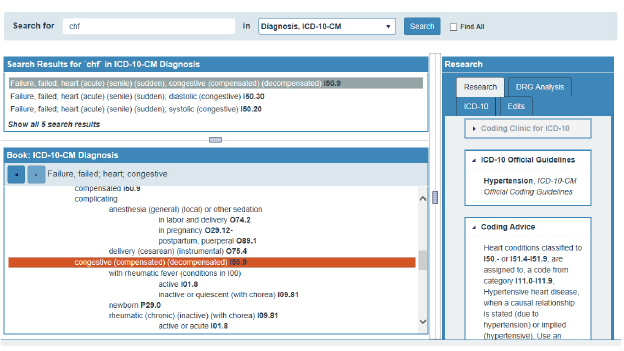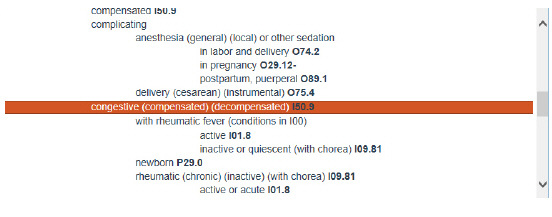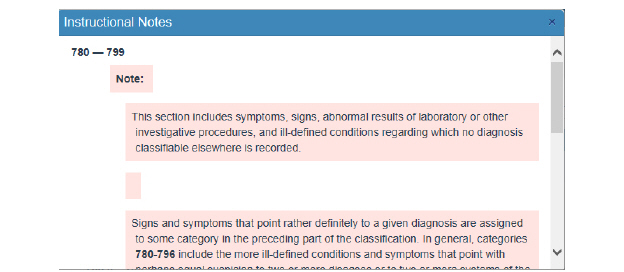
Searching by Index
When searching a code book by terms, the alphabetic index is searched and appears in the control.

The following elements are shown:
Search Results pane – This pane displays all index entries from the alphabetic index that match the search terms.

Context bar – This bar shows the alphabetic index location of the index entry selected in the Detail pane. The Context bar changes when you focus on a different entry in the Detail pane.

Detail pane – This pane displays the alphabetic index for the index entry selected in the Search Results pane.

Backward and forward navigation – Click the left arrow to move back and the right arrow to move forward through the codes you have viewed.

Find All search – A Find All search looks for terms outside of the structure of the index. The search results display all occurrences of the terms in the code book that is searched.

Complication icon – ![]() Symbol indicates a major complication or comorbid condition.
Symbol indicates a major complication or comorbid condition.
Click the Instructional Notes icon ![]() to view additional notes for this code.
to view additional notes for this code.

Click anywhere on the page to close the Instructional Notes.
You can search the following tables:
Neoplasm table – In the ICD-10-CM diagnosis code books, this table lists anatomical sites alphabetically, with columns to indicate the code for each behavior type, such as primary, secondary, benign, etc.
Table of Drugs and Chemicals – In the ICD-10-CM diagnosis code books, this table contains a classification of drugs and chemicals to identify poisoning states and external causes of adverse effects.
The following additional Index features are available:
See and See Also cross-references – The indexes include See and See also instructions which are cross-references to other areas of the index.
Synonym search – Synonyms are acronyms, abbreviations and shortcuts you can use to search the alphabetic index. Performing a search using a Synonym is the same as a search using terms.
Custom index lines – Custom index lines are alphabetic index entries that have been added to the official indexes. These entries are noted with the “T” symbol before the alphabetic index line. The source of the custom index line is noted in parentheses.
E code search – The E code index (external cause of injury index) functions the same as the other indexes. Like the other indexes, you access it from the code book drop-down list. Within the structure of ICD-10-CM, there are many E codes with sub-terms of one or two words, such as by, with, due to, and from. You do not need to enter such terms in the encoder search. ICD-10-CM external cause of morbidity codes do not begin with an E. They begin with the characters V, W, and X.
Minus sign icon – In the ICD-10-CM index, a minus sign follows codes that require additional characters. To view the additional characters, click on the code to proceed to the tabular.
See Also
Searching for an ICD-10-CM Code
Searching for an ICD-10-PCS Code
Searching All Occurrences of a Term